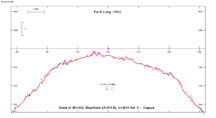Graze of ZC 951 at Pt. Reyes
Apr 5/6, 2014
This is a bright graze of a close double star, magnitude 6.6 total (5.8 in red) which may help refine the binary orbit. It also has a good track at 1.08 mi south of the limit, which goes exactly across one of my favorite places - the hostel at Pt. Reyes. I've had trail runs, kayaking adventures, and oyster dinners here, and it may be a good way to cap Spring Break.
The prediction page is here. Central graze is at 6:46:00 UT or 11:46:00pm. The graze is a suspected binary of magnitude 7.1 and 8.4, with PA 64 degrees, north of the primary.

Northern limit profile for long 123.0. The hostel is at 1.08 mi south. |

Graze line plotted for 440 ft elevation, but true elevation at the hostel is 153 ft, so the 1.08 mi figure is going to be a bit larger, maybe 1.10 mi south. You can get 0.05 mi closer by setting in the open field area halfway to the trailhead further east. |
Late change of plans - due to a climate-related meeting in Ben Lomand, I decided to postpone (yet again) my next adventure in Pt. Reyes, and join Ted Swift, Derek, and perhaps one or two more, for the graze as it passes through Pleasanton... occultations predictions . The central graze is 11:46:46pm

Pleasanton graze site
The best sites are at 0.8miS, 1.1 mi S, and 1.6 mi S. at this longitude. |

Profile from Pleasanton at 121.90 longitude |
|
|
Observations
I drove to the observatory and picked up the 10" scope, and my office and packed the video gear, then hit the freeway and arrived in Pleasanton an hour before the graze. Ted and his daughter Elinor were already set up, in the parking lot for the park, not far from Bernal Rd. He showed me his compact gear box and how nicely it set up with just an opening of the case, plugging a few wires, and it was ready to go. I'll try and model my own box(s) on the same theme. We three talked for a while, then with 40 minutes to go it was time for me to head to my own site. I'd selected the track 1.08 miles south, Ted was at about 0.88 miles south. Here's my timings... They are all assuming 25% light as the geometric moment of "D", and step by step field stepping visually (i.e. I did not import into LiMovie). The first D was a bit gradual, and the RD soon after was definitely gradual, and in fact never attained full brightness. The timings should all be accurate to 0.03 seconds. Seeing was poor, but the star was bright and easy.
I used a IOTA VTI and 10" f/10 telescope with PC164C with Bumgarner manual gain, set as bright as necessary to see the earthlit moon, but no so bright as to overwhelm with the nearby moon in the frame.
Begin 6:44:00
D 6:45:51.9557
R 6:45 53.2903 Gradual
D 6:45 53.5906 Gradual, achieved about 40% of full brightness midway between this and the previous R
R 6:47:05.5955
B 6:47:09.218 (blink). Disappeared down to about 10% of normal light for 3 or 4 frames.
D 6:47:12.6347 This and the rest were fairly sharp and crisp.
R 6:47:14.2420
D 6:47:18.1401
R 6:47 24.0550
end 6:48:28
Long 121deg 54.0317min
Lat 37deg 38.9932'
altitude 91.6 meters
WGS84 coord frame



